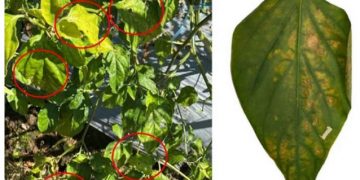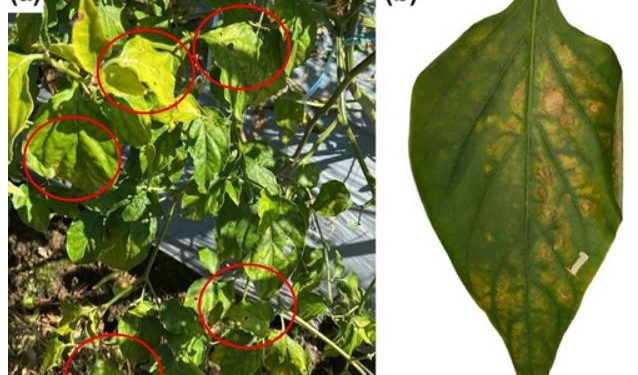Chilli pepper (Capsicum spp.) is an important crop with increasing global consumption; the top three chilli pepper-producing countries are China, Mexico and Indonesia. The disease has been reported in Indonesia but there is no information about the causal agent.
In April and May 2022, bacterial leaf spots were observed in a commercial plantation in Bantul, Yogyakarta, Indonesia (8°00’5.5“ S and 110°18’46.9” E). Small black lesions were observed on the leaves . These lesions were surrounded by yellow circles or irregular, dark brown or black greasy spots . A total of 100 diseased leaves were collected and surface-sterilised with 70% ethanol then wiped with absorbent paper. Squares containing individual lesions were excised from the samples using a sterile scalpel and bisected. One half of each lesion was placed on a drop of sterile water on a microscope slide and overlaid with a coverslip to inspect for oozing (×100 magnification), the other half was placed in an another drop of water for culturing and as a crude PCR template. Bacterial oozing was observed in almost all lesions sectioned. For six ooze-positive samples, bacteriological streaks on nutrient agar plates supplemented with 2% starch were made from the second set of samples. Plates were sealed with plastic film and incubated for 48 hours at 28°C.
Following isolation and successive subculturing (×3) from single colonies, one isolate was obtained (BY1) and an amylase test was conducted to differentiate X. euvesicatoria pv. euvesicatoria from X. vesicatoria and X. euvesicatoria pv. perforans which also cause bacterial leaf spot. After incubation at 28°C for 48 hours, three drops of 10% iodine solution were added onto the edge of the colonies and were observed as amylase-negative owing to the lack of clearing in the medium.
The bacterium was further identified by molecular characterisation.
A pathogenicity trial was conducted in a greenhouse using two chilli pepper species (C. frutescens cv. Trisula Hijau and C. annuum var. annuum). The isolate was grown on nutrient agar and incubated for 48 hours at 28°C. Single colonies obtained from the pure cultures were suspended in distilled water and adjusted to 1 × 108 CFU/ml. Three five-week-old chilli pepper plants were inoculated with the bacterial suspension by spraying 1 ml bacterial suspension per leaf. Control plants were treated with sterile distilled water. Black spot symptoms, consistent with those observed in the field, were seen after four days in both chilli pepper species but no symptoms were seen on control plants. Symptoms on inoculated plants were ooze-positive, and the ooze was confirmed positive for X. euvesicatoria pv. euvesicatoria using the Xeu2.4/Xeu2.5 and gyrB-F/gyrB-R primers.
Based on the biochemical, molecular and pathogenicity tests, the strain isolated from chilli pepper in Indonesia was identified as X. euvesicatoria pv. euvesicatoria. Bacterial leaf spot on chilli pepper has probably existed for some time in Indonesia but this is the first report of the aetiology of the disease.
Reference: Utami, D., Jayasanti, N.N.S., Meale, S.J. & Young, A.J. (2023) First report of Xanthomonas euvesicatoria pv. euvesicatoria causing bacterial leaf spot in chilli pepper (Capsicum sp.) in Indonesia. New Disease Reports, 48, e12208. https://doi.org/10.1002/ndr2.12208































